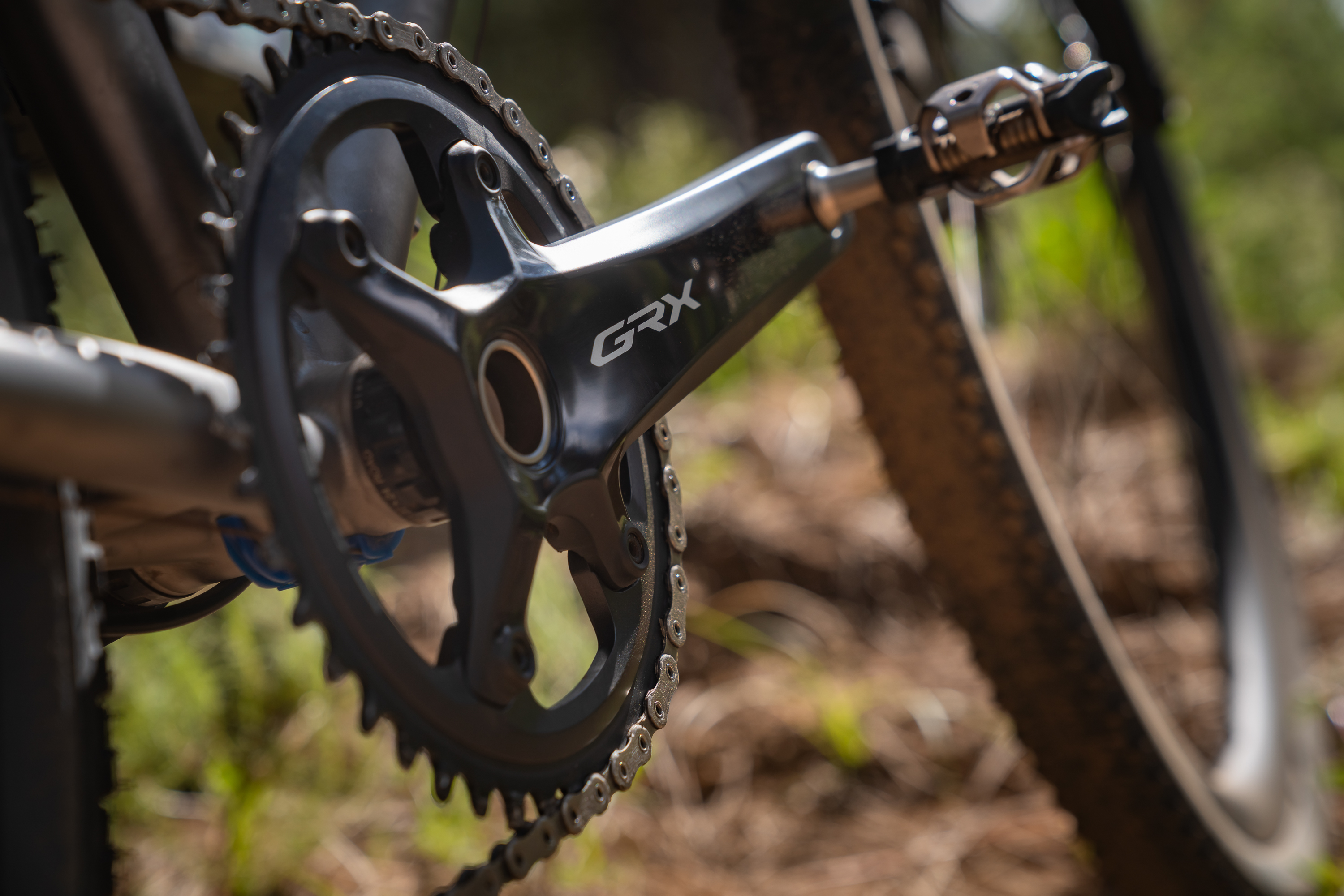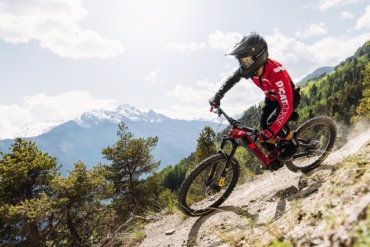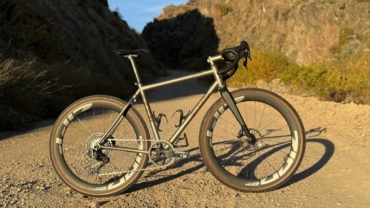With SRAM offering 12-speed on gravel for a while now and Campagnolo flexing 13-speed, Shimano seemed to be on the back foot.
But Shimano doesn’t jump on bandwagons. It has yet to join the carbon crankset party, for example, sticking to tried and true aluminum. When it does make significant advances, it’s usually with precision and excellent functionality, which the brand has repeated ad infinitum. So, when Shimano informed me of an upcoming 12-speed GRX groupset, the brand had my full attention.
I was shocked to hear that it was a mechanical groupset. After riding the brand’s 11-speed GRX Di2 version, I didn’t know why anyone would not want to move to electronic shifting for gravel riding if able. And I couldn’t fathom why Shimano wouldn’t want to knock it out of the park by launching its first 12-speed gravel groupset as a Di2 electronic version.
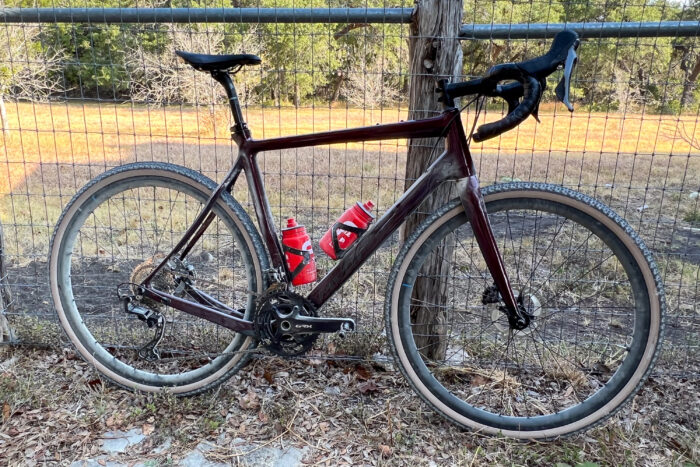
But after a first and only ride before the launch, I’m happy to report that the new GRX 12-speed Mechanical RX820 groupset functions, well, like you would expect a high-end Shimano groupset would. It was an excellent performer, and I expect it will continue to perform admirably. Look for a full, long-term review in the future.
In short: It was worth the wait. The Shimano GRX 12-speed RX820 gravel bike groupset combines innovation with the reliability of a mechanical groupset. It shifted, braked, and felt impeccable, and gripes were extremely minimal. And if you are set on a mechanical groupset for your gravel or bikepacking rig, it will be hard to do better than the Shimano GRX RX820.
Shimano GRX 12-Speed Mechanical Gravel Bike Groupset Basics
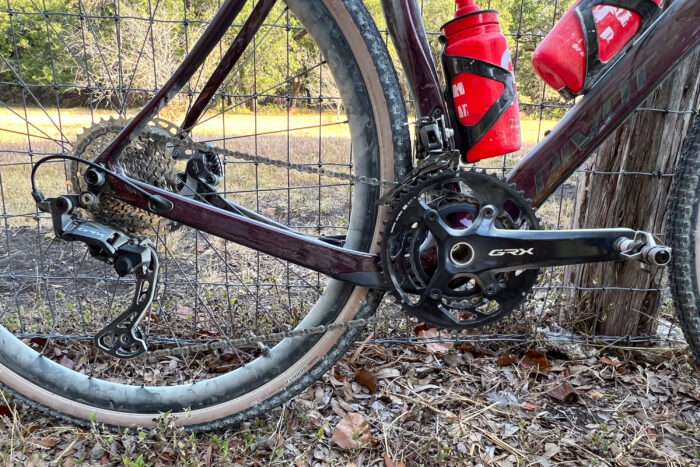
Drivetrain
Shimano offers the GRX RX820 drivetrains in three flavors. Two single-ring setups and one double-chainring version. The 1x versions have a 40- or 42-tooth chain ring mated to either a 10-45-tooth cassette or a 10-51. The double chainring model comes with 31- and 48-tooth chainrings and an 11-34 or 11-36-tooth cassette.
These potential combinations provide a wide variety of gear ratios. The 1x version’s gear ratios can be as low as 0.78 or as high as 4.2. The double-ring setup can go as low as 0.86 and as high as 4.36.
All versions have a rear derailleur with Shimano’s Shadow RD+ clutch system, which can be disengaged. A rear derailleur clutch helps prevent the derailleur cage from swinging forward. This keeps the tension on the chain much more consistent, reducing chain slap and dropped chains. It also keeps the derailleur cage more retracted, lessening the chances of getting snagged on trail obstacles.
The 2x version’s front derailleur gets sits 2.5mm further outward than road units, allowing room for mud buildup on the tire. This could come in handy with wider rubber becoming more popular.
Shimano GRX Ergonomics
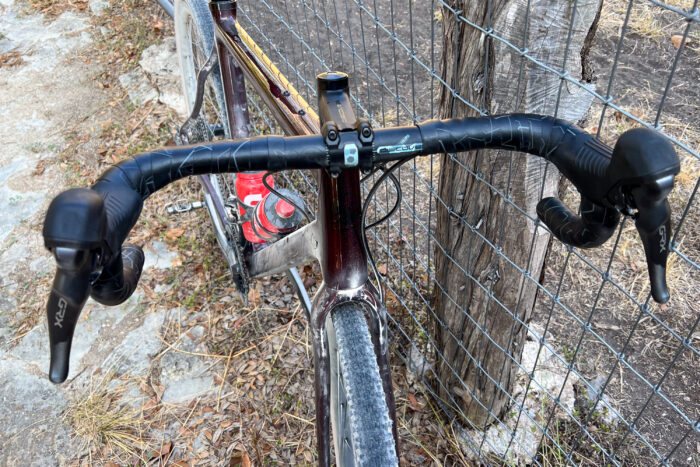
Flared drop bars have been around for a while on the gravel scene, but I never liked how brake hoods felt on them. I’ve been switching out my flared bars to regular road drop bars. Shimano cleverly designed the brake hoods and levers to accommodate this flare. Kudos!
Shimano returns with the textured hood surface and antislip brake/shift lever coating to enhance grip when it gets rough and hands are sweaty.
Brakes
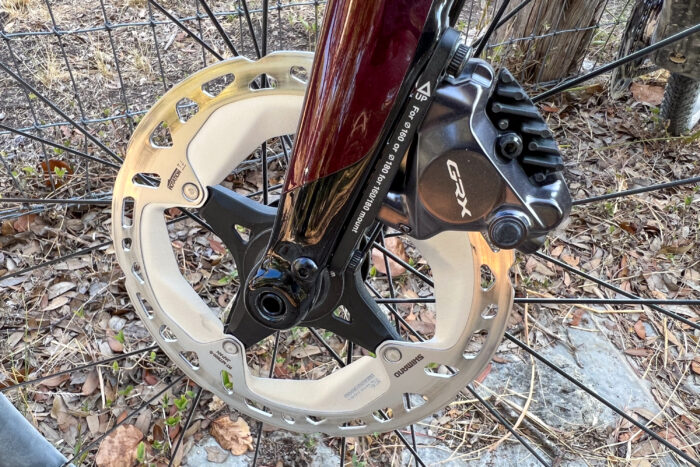
Shimano graces the brake rotors with its ICE TECHNOLOGIES FREEZA, touting less brake fade and noise and longer pad life. This technology uses an extended aluminum inner layer with cooling fins that the brand says reduce heat buildup by 212 degrees compared to stainless steel rotors.
The rotors also have a 3D-shaped aluminum carrier; Shimano manipulates every dimension to help dissipate heat and reduce heat-induced distortion and braking noise.
The GRX brake pads have a 10% wider clearance between them than before. This should help reduce rotor rub.
Two GRX Levels
In addition to the Shimano GRX 12-speed Mechanical RX820 described above, the brand also released a lower-priced 12-speed mechanical tier. Dubbed RX610, the lineup is priced significantly lower, and it comes in both 1x and 2x versions.
The tiers share front and rear derailleur, but other major components like shift/brake levers, cranksets, and brake components differ. This First Look Review is based on the GRX RX820 groupset.
Shimano GRX 12-Speed Mechanical First Ride Review
My Pivot Vault came 2x with the 11-36 cassette. And just like the 11-speed GRX, the subdued grey hues and graphics immediately won me over. The visuals of the groupset matched my perception of the brand: don’t be flashy, quietly refine performance.
It’s important to note that for a few years, I have not ridden anything but electronic drivetrains on my gravel and road bikes. I was somewhat shocked that Shimano didn’t launch a Di2 electronic version as its first foray into 12-speed gravel drivetrains. Admittedly, I was skeptical that it would impress me, even with the added cog out back.
But only a few miles down the dusty gravel roads around my Wimberley, Texas, home, my negativity faded. This mechanical drivetrain worked great. Yes, there are some things that I missed from electronic drivetrains, but there were also long-term gains I expect to experience as I continue with the long-term test.
Shifting
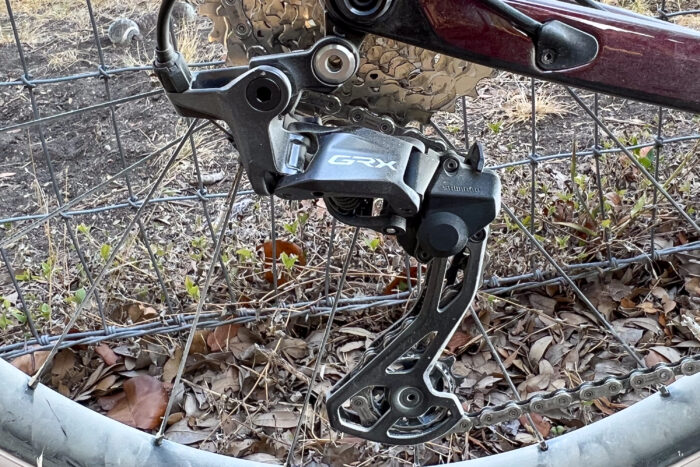
Rear shifts were precise, and I never missed one during my 2-hour first ride. Shimano has been in the indexed and integrated shifting game for decades, and it showed. I was never hung between gears or felt any struggle to move the chain to the exact correct alignment with the cog.
Yes, the shifting overall was slower than on my 11-speed GRX Di2, but I felt most of that was due to moving the shift lever versus just tapping a button. Once I moved the shift lever, the derailleur and chain quickly engaged the correct cog. This engagement was fast enough for me to feel like there wasn’t time lost there compared to Di2.
The Shadow RD+ rear derailleur clutch worked amazingly well. I was worried when I noticed Pivot didn’t attach a chainstay guard. But it was unnecessary as I never heard the chain slap once, and I have high-speed sections over limestone bedrock that require an iron-clad grip on the brake hoods to stay on the bike.
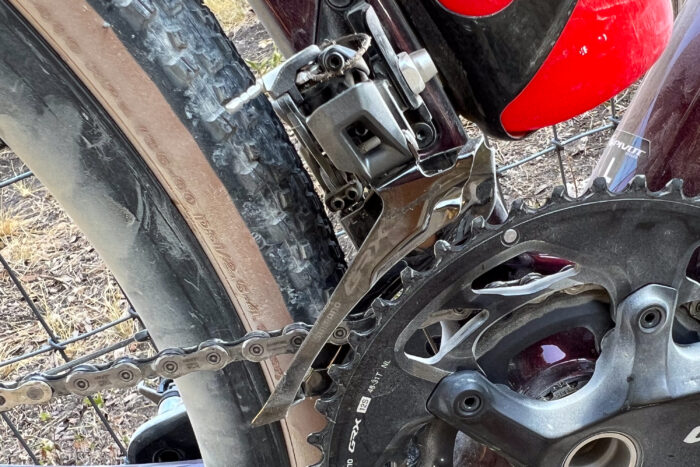
The front derailleur’s performance matched the rear’s. It shifted precisely and quickly once I moved the shift lever through its range. I never dropped a chain or had the chain skip before catching the chainring teeth.
I had two minor quibbles with shifting. The first was the clearance between the back of the shift levers and the handlebars. For me, it wasn’t enough. I hit or rubbed the back of my index or middle finger on the back of the shift levers. It was nothing painful, just noticeable and fairly consistent. It could be how I relax those fingers while on the hoods, relying on my thumbs to anchor my grip.
Secondly, the chain engaging or disengaging with the rear derailleur jockey wheels was very noisy. This was surprising, as the jockey wheels are much larger than on the 11-speed GRX, and I had gone through the trouble of degreasing and waxing the brand-new chain.
It was loud enough for me to think the chain was rubbing the front derailleur cage. I didn’t pinpoint the source of the chatter until I put it up on the stand when I got home.
Braking
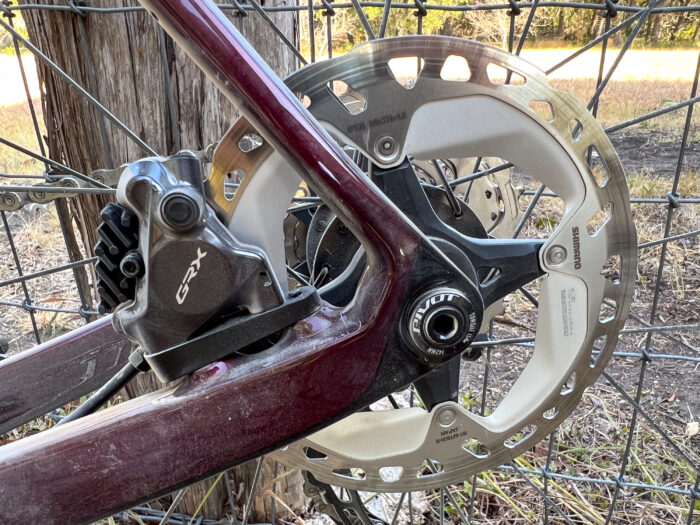
Dear Shimano: Please replicate the brake lever ergonomics to all your other groupsets. It was perfect.
The brake levers on the Shimano GRX 12-speed Mechanical groupset were amazing. The higher lever pivot point and wide, flat surface and nonslip coating delivered the right feel and feedback that allowed consistent and relaxed braking from both the hoods and the drops, even when my hands were sweat-drenched. I wish all brake levers had these amazing ergonomics.
As I did with the 11-speed GRX, I found the ribbed surface of the brake hoods to be a little too aggressive when my hands got soft later in the ride from constant sweating. But I will admit I have sensitive skin on my hands.
Once the rotors got bedded in after concentrating on doing it during the first half of the ride, the braking was just like I’d experienced on other Shimano disc brakes. The GRX units had a great initial bite and a predictable and progressive feel as I pulled the lever in further. And the calipers could have delivered more total power than I’ll ever need on gravel. It’s hard to imagine how Shimano could improve on these brakes.
Conclusions on Shimano GRX 12-Speed Mechanical
Shimano may not present itself with flashy, over-the-top marketing, nor does it make everything out of carbon. But when Shimano does launch significant changes, to me, it does get closer to perfection than any other component brand.
Yes, the brand can seem somewhat staunch, seemingly waiting for other brands to break trail. I view the lack of chainring options and power meter as an example of such overly conservative behavior. But historically, for me, waiting for Shimano to “catch up” has been worth it, and sometimes it causes other brands to then catch up themselves.
The release of the brand’s first 12-speed gravel group didn’t initially blow my doors off. I thought, “OK, cool, welcome to 12-speed, finally,” and I questioned why the company didn’t just go all out and launch the Di2 electronic version. But after one ride, I’m fully on board. Mechanical shifting is not dead, and Shimano executes it incredibly well.
In some cases, I can see mechanical being an advantage over electronic. Bikepacking is the obvious category that could do without the hassles of battery charging or electronic gremlins playing havoc in the middle of nowhere.
But I can also see mechanical being the way for those of us who want a “set and forget” daily rig. I’ve run out of battery juice a few miles from home more than once; it wasn’t catastrophic, but it stole time away from the only hour I had to myself those days.
And finally, the economics. Mechanical groupsets cost much less than their electronic counterparts. Shimano GRX 12-speed Mechanical RX820 full groupsets range from an MSRP of $1,543 to $1,585. The RX610 versions range from an MSRP of $1,166 to $1,234. For comparison, the Shimano GRX 11-speed Di2 ranges from roughly $1,872 to $2,139.
